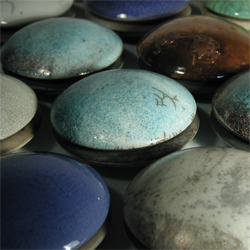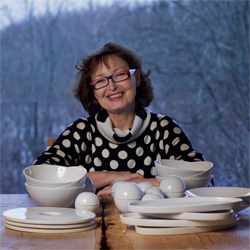

 |

|
 |
 |
 |
| Karin Widnäs is well known as a versatile and prolific ceramicist. In addition to unique esthetic objects and pieces of tableware the emphasis of her work for the past two decades has been the design of architectural ceramic elements. Her red clay and raku tiles are today widely seen in both public spaces and private indexs. Karin Widnäs settled in Fiskars in 1995, when the arrival of artisans, designers and artists revived the fortunes of the moribund industrial village. The new inhabitants quickly organized themselves into a co-operative in which Karin Widnäs has been a key figure. In Fiskars, Widnäs realized her great dream by building her own house, incorporating an atiljé. This symphony of local timber, Widnäs ceramics, clean lines and pure light, designed by architect professor Tuomo Siitonen, has attracted international attention. Ten years in the raising, the house finally stood complete on Hasselbacka Hill, in 2005. The Cultural Capital year in Turku, 2011, began with the dedication of a major public art work by Karin Widnäs on the bank of the Aura river: an old pump-house tower, clad in robust ceramic plates, illuminated variously to reflect the changing rhythms of the day. Appropriate to its’ characteristic form the piece bears the title “Kimono”. Karin Widnäs has now been drawn back to utility ceramic ware. When she heard that Helsinki had been designated Design Capital for 2012, Widnäs expressed a wish to develop a bespoke dinner service for a top Helsinki restaurant, in consultation and collaboration with that restaurant’s chef. The Savoy Restaurant, the most traditional of all in Helsinki and a jewel in the city’s culinary crown, was a natural choice. Karin Widnäs had long admired Alvar Aalto´s work and vision, even to the extent of employing them in her ceramic fountains. |